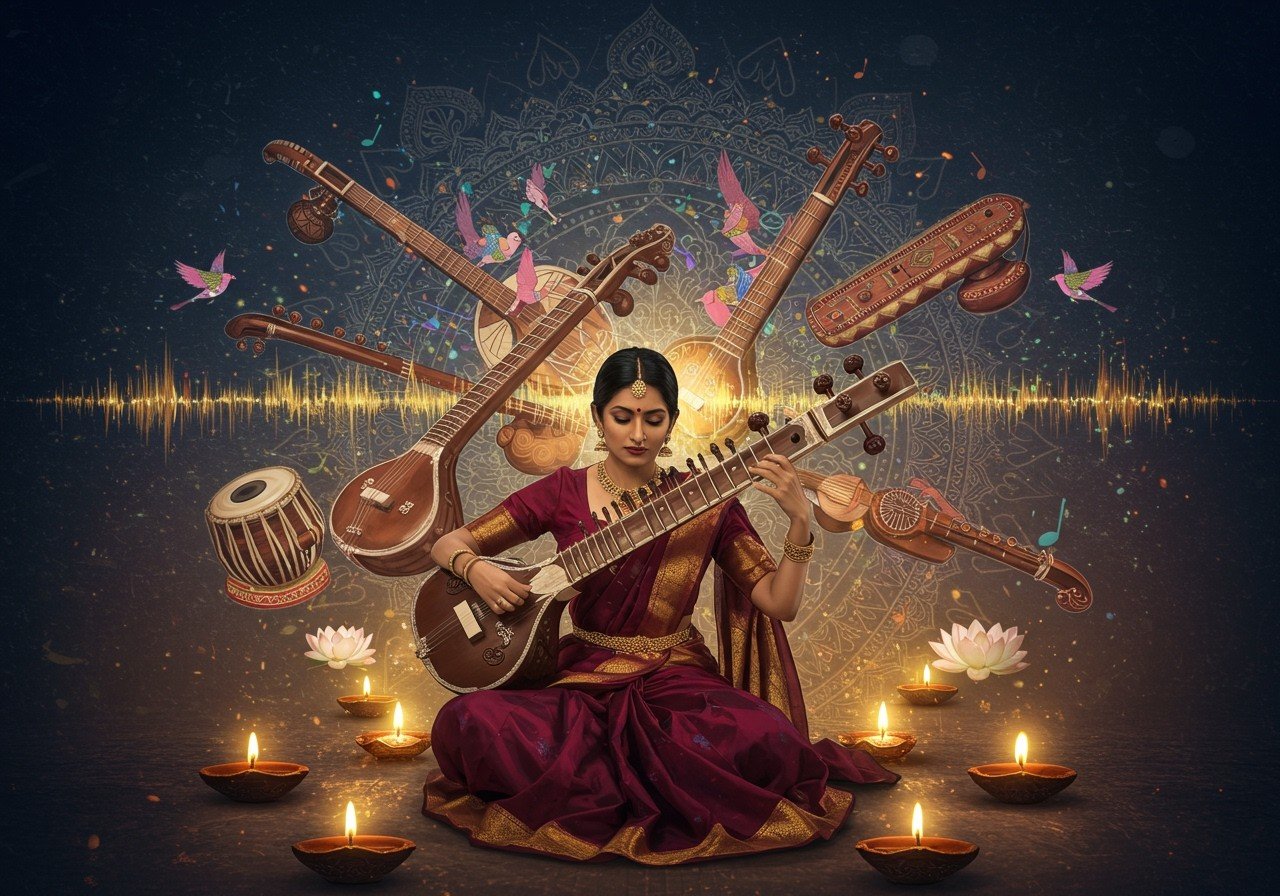
India, a land of rich cultural heritage, boasts a diverse and vibrant music scene. Indian music is an amalgamation of various musical styles, each reflecting the country’s unique traditions and regional identities. This blog explores the myriad sounds of Indian music, providing insights into its types, famous genres, and the cultural significance of music in India. It caters to culturally rooted, middle to upper-middle-class Indians aged 25-60 who value tradition and prefer authentic ritual items with the convenience of online shopping.
Understanding Indian Music
Indian music encompasses various styles, both classical and contemporary, each with its distinct characteristics. The music of India is deeply intertwined with its cultural and religious practices. Key types of Indian music include Carnatic and Hindustani classical music, which have deep historical roots. Folk music includes styles like Borgeet, Baul, Bhajan, Kirtana, and Shyama Sangeet. Additionally, there are lighter classical forms like Dadra. Each type of music has its unique origins, features, and instruments, contributing to India’s vast musical heritage.
Key Elements of Indian Classical Music
- Raga: A fundamental element defining the melody and evoking specific emotions and moods. Ragas are complex melodic structures that form the basis of improvisation and composition in Indian classical music.
- Tala: The rhythmic pattern forming the backbone of compositions. Talas provide the rhythmic framework for Indian music, creating a cyclical structure that guides the musicians.
Traditional Musical Instruments
- Sitar: A string instrument used in classical and folk music known for its resonant and evocative sound. The sitar is often associated with Indian classical music and is played by plucking the strings with a wire pick.
- Tabla: A percussion instrument essential in classical and contemporary music, providing rhythmic accompaniment. The tabla consists of two drums played with the hands, creating a wide range of percussive sounds.
- Veena: An ancient string instrument with deep cultural significance, often associated with Goddess Saraswati. The veena is a plucked string instrument with a long neck and a resonating body, known for its mellow and melodious tone.
Types of Music in India
India’s music scene is incredibly diverse, with each region contributing its unique sounds and styles.
Classical Music Forms
- Hindustani Music: North Indian classical style characterized by its elaborate ragas and talas. Hindustani music emphasizes improvisation and features instruments like the sitar, tabla, and sarod.
- Carnatic Music: South Indian classical tradition known for its complex melodic structures and rhythmic patterns. Carnatic music is based on a system of ragas and talas and often features instruments like the veena, mridangam, and flute.
Regional Folk Styles
- Bhangra: Energetic dance music from Punjab, often played during celebrations and festivals. Bhangra is characterized by its lively rhythms, upbeat tempo, and use of traditional instruments like the dhol and tumbi.
- Garba: Traditional dance music from Gujarat, performed during the Navratri festival. Garba is a circular dance form accompanied by rhythmic clapping and singing, often performed around a central image of the goddess Durga.
- Lavani: Folk music from Maharashtra, known for its expressive lyrics and rhythmic melodies. Lavani is a traditional dance form that combines elements of music, poetry, and storytelling, often addressing social and political themes.
Devotional Music
- Bhajan: Spiritual songs sung in praise of deities, often performed in temples and during religious gatherings. Bhajans are devotional songs that express love and devotion to God, often accompanied by simple musical instruments.
- Qawwali: Soulful music expressing spiritual themes, traditionally performed by Sufi musicians. Qawwali is characterized by its passionate vocals, rhythmic clapping, and use of traditional instruments like the harmonium and tabla.
Famous Musicians of India
India has produced numerous legendary musicians who have left an indelible mark on its musical landscape.
- Ravi Shankar: Renowned sitar player who popularized Indian classical music worldwide.
- Lata Mangeshkar: The ‘Nightingale of India’ known for her melodious voice and countless hit songs.
Cultural Significance of Indian Music
Indian music is not just an art form but a vital part of the country’s cultural and social fabric.
Music in Religious Ceremonies
The use of devotional songs and chants in temple rituals and festivals enhances spiritual experiences.
How Poojn.in Supports Your Musical Journey
Poojn.in offers a wide selection of products to enhance your musical and spiritual experiences. As Goddess Saraswati is the patron deity of music, we provide items to create a sacred space for your musical pursuits.
- Pure brass and silver Saraswati idols: Beautiful and authentic idols for your music room or altar, perfect for honoring the goddess of music and knowledge. These idols can serve as a focal point for inspiration and devotion during practice or performance.
- Traditional incense and incense holders: Create a calming and sacred atmosphere with our selection of incense. Choose from a variety of fragrances to enhance your focus and concentration during practice.
- Complete puja kits for Saraswati puja: Everything you need for a traditional Saraswati puja, conveniently packaged for your convenience. Honor the goddess of music and knowledge with a dedicated puja.
Conclusion: Embracing the Richness of Indian Music
Indian music is a treasure trove of diverse sounds, reflecting India’s rich traditions and cultural heritage. From classical melodies to vibrant folk tunes, every style tells a story. As you explore Indian music, you’ll find a deep connection to the cultural and spiritual practices that have shaped India for centuries.


